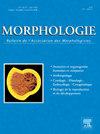Sexual dimorphism assessment through morphological analysis of the sella turcica in multislice computed tomography scans
Q3 Medicine
引用次数: 0
Abstract
The sella turcica (ST) is a depression located within the sphenoid bone in the middle cranial fossa. It houses the pituitary gland and serves as a crucial cephalometric landmark for craniofacial growth assessment. Given that several studies have analyzed its dimensions using imaging, some researchers have proposed evaluating its morphology in relation to sex, considering it a potential structure for human identification in forensic anthropology. This study aimed to assess sexual dimorphism through morphological evaluation of the ST in multislice computed tomography (MSCT) scans of individuals from Northern and Northeastern Brazil. A cross-sectional observational study was conducted using 200 MSCT scans equally distributed between sexes, from individuals aged 18 to 49 years. Sagittal sections were analyzed using RadiAnt software, based on morphological classifications proposed by Axelsson (normal, oblique anterior wall, pyramidal, double contour, bridging, and dorsum irregularity) and Yasa (oval, round, and flat). Descriptive analyses of qualitative data and correlations between ST morphology and sex were performed. Morphological correlations showed that the normal form was significantly more frequent in males (80%) than females aged 18–29 years (P = 0.005). Conversely, the oblique anterior wall was more prevalent in females (23.1%) within the same age range (P = 0.002). The round shape was significantly more common in young males (43.1%) compared to females (P = 0.026), while the flat shape was more frequent in young females (61.5%) (P = 0.023). Other morphological types showed no significant sex differences across age groups. Based on this study, morphological features such as the normal shape, oblique anterior wall, round, and flat types serve as predictors of sexual dimorphism in individuals under 30 years of age.
通过多层计算机断层扫描的蝶鞍形态学分析评估性别二型性
蝶鞍(ST)是位于中颅窝蝶骨内的凹陷。它容纳脑垂体,并作为颅面生长评估的重要头侧测量标志。鉴于有几项研究使用成像技术分析了它的尺寸,一些研究人员建议评估它的形态与性别的关系,认为它是法医人类学中人类识别的潜在结构。本研究旨在通过多层计算机断层扫描(MSCT)对巴西北部和东北部个体ST的形态学评估来评估性别二态性。一项横断面观察性研究使用200个性别平均分布的MSCT扫描,从18岁到49岁的个体。根据Axelsson(正常、斜前壁、锥体、双轮廓、桥接和背不规则)和Yasa(椭圆形、圆形和扁平)提出的形态学分类,使用RadiAnt软件对矢状面切片进行分析。描述性分析定性数据和ST形态和性别之间的相关性进行。形态学相关性显示,18-29岁男性的正常形态发生率(80%)明显高于女性(P = 0.005)。相反,在相同年龄范围内,斜前壁在女性中更为普遍(23.1%)(P = 0.002)。青年男性以圆形多见(43.1%)(P = 0.026),而青年女性以扁平多见(61.5%)(P = 0.023)。其他形态类型在不同年龄组间无显著的性别差异。基于这项研究,形态学特征,如正常形状、斜前壁、圆形和扁平型可作为30岁以下个体性别二态性的预测因子。
本文章由计算机程序翻译,如有差异,请以英文原文为准。
求助全文
约1分钟内获得全文
求助全文
来源期刊

Morphologie
Medicine-Anatomy
CiteScore
2.30
自引率
0.00%
发文量
150
审稿时长
25 days
期刊介绍:
Morphologie est une revue universitaire avec une ouverture médicale qui sa adresse aux enseignants, aux étudiants, aux chercheurs et aux cliniciens en anatomie et en morphologie. Vous y trouverez les développements les plus actuels de votre spécialité, en France comme a international. Le objectif de Morphologie est d?offrir des lectures privilégiées sous forme de revues générales, d?articles originaux, de mises au point didactiques et de revues de la littérature, qui permettront notamment aux enseignants de optimiser leurs cours et aux spécialistes d?enrichir leurs connaissances.
 求助内容:
求助内容: 应助结果提醒方式:
应助结果提醒方式:


